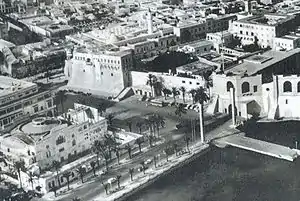Martyrs' Square, Tripoli
The Martyrs' Square (Arabic: ميدان الشهداء Maydān ash-Shuhadā'[1][2]); known as Green Square (الساحة الخضراء as-Sāḥah al-Khaḍrā') under the Gaddafi government; Independence Square (ميدان الاستقلال Maydān al-Istiqlāl) during the monarchy; and originally (during Italian colonial rule) known as Piazza Italia ("Italy Square") is a downtown landmark at the bay in the city of Tripoli, Libya. The main commercial center of the city surrounds the square.[3] The Square is also a main tourist attraction in Tripoli. It has a large legendary fountain done by an Italian architect at the centre of the square. The square is the meeting point of many different avenues. Omar Mukhtar Avenue is one of the longest in North Africa, it was built by Italians in the colonial time, and Libyans during the era of King Idris I. Independence Street branches from the square too, and it leads to the Palace of King Idris I. 24 December Avenue is also an Italian built avenue. Mizran Street is the last street that branches from the Martyrs' Square.
Martyrs' Square ميدان الشهداء Maydān ash-Shuhadā' | |
|---|---|
| Neighborhood | |
 The Martyrs' Square (then known as "Green Square") in 2007 | |
| Features | fountain |
| Dedicated to | 2011 Battle of Tripoli |
| Location | Intersection of Independence Street, Omar Mukhtar Avenue, 24 December Avenue and Mizran Street Tripoli, Libya |
| Coordinates: 32°53′42″N 13°10′52″E | |
History



The square was originally constructed by the Italian colonial rulers on the site of the old bread market (sūq al-khubs), and it was expanded on several occasions during the 1930s.
During the Italian colonial period, it was called Piazza Italia ("Italy Square"). After Libyan independence in 1951, it was known as "Independence Square" during the Libyan monarchy (1951–1969). After the 1969 revolution by Gaddafi, the square was renamed again to "Green Square"[4] to mark his political philosophy in his Green Book.[5]
2011 Libyan civil war
On the night of 21–22 August, Libyan rebel groups took control of the area during the 2011 Battle of Tripoli and started referring to it as Martyrs' Square to dissociate the square from the Gaddafi government and to commemorate those who died in the fight against his government.[6][7] On Eid ul-Fitr (31 August) and again on 2 September, tens of thousands of Tripoli residents, including many women and children, gathered on Martyrs' Square to celebrate the end of Gaddafi's rule.[8][9]
Facilities
It features the Red Castle[10] (As-saraya Al-hamra), which hosts Libya's Antiquities Department and the National Museum with a collection of Phoenician, Greek and Roman artefacts. The museum also exhibits a statue of Venus from the Hadrianic Baths at Leptis, a complete Libyan-Roman tomb from the Ghirza region, and a colourful Volkswagen Beetle used by Colonel Gaddafi leading up to the revolution.[11] On the other side, a wide avenue leading towards the seafront with two tall pillars. On top of the pillars are an iron-cast, miniature wooden ship; the other one features a horseback rider.
The Royal Miramare Theatre used to be located across from the Red Castle, but it was demolished by Gaddafi's government after the 1960s to create space for large demonstrations.
See also
References
- The Independent, 31 August 2011. Gaddafi Son Offers to Surrender "..in Martyrs Square, the plaza formerly known as Green Square.."
- Jalil's speech in Martyrs Square, The Guardian, 13 September 2011
- "Libya Tripoly from Libyaonline.com". Libyaonline.com. Archived from the original on 6 March 2011.
- "The symbolic importance of Green Square". 22 August 2011.
- "Libyans turn out big, then celebrate historic election".
- Staff (28 August 2011). "Sky Correspondent On 'Amazing' Tripoli Scenes". Sky News. Retrieved 31 August 2011.
- Garcia-Navarro, Lourdes (24 August 2011). "Libyan Rebels Struggle To Impose Order on Tripoli". NPR. Retrieved 31 August 2011.
- Joyful crowds pack Martyrs’ Square in Tripoli Euronews, 31 August 2011
- Tripoli celebrates first post-Gaddafi Eid, Al Jazeera, 31 August 2011.
- "The Libya-Italy archaeological exhibition opened in Red Castle yesterday – before moving to Benghazi in January". 23 September 2021.
- Chris Bradley (9 March 2006). "Gateway to ancient wonders". The Guardian. Retrieved 19 September 2017.
External links
 Media related to Green Square (Tripoli) at Wikimedia Commons
Media related to Green Square (Tripoli) at Wikimedia Commons